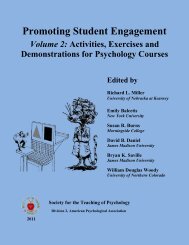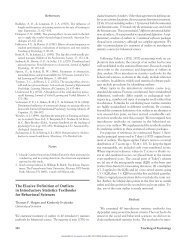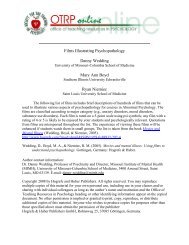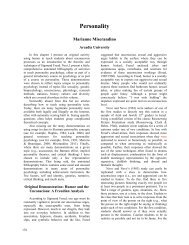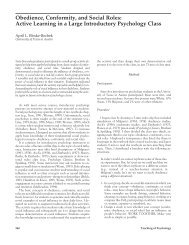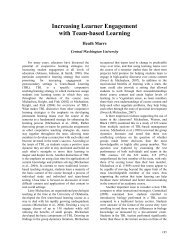INTRODUCTORY PSYCHOLOGY TEACHING PRIMER Early Career ...
INTRODUCTORY PSYCHOLOGY TEACHING PRIMER Early Career ...
INTRODUCTORY PSYCHOLOGY TEACHING PRIMER Early Career ...
You also want an ePaper? Increase the reach of your titles
YUMPU automatically turns print PDFs into web optimized ePapers that Google loves.
y the task, may not be able to best use the resources available, and may not even know where<br />
to begin.<br />
This basic primer for the teaching of the introductory course summarizes best practices and selects<br />
from the many resources available, to provide a starting instructor with a clear, concise, and<br />
concrete set of tools sufficient to successfully teach an introductory course for the first time. It is<br />
also designed to provide the experienced instructor with suggestions and tips that can invigorate<br />
a course taught many times over. Akin to guides provided for visiting cities or theme parks that<br />
provide recommendations for what the person can do based on how much time they had -- if you<br />
have a full day at Legoland/in New York city here is what to do. If you only have half a day,<br />
here is what you do-- this primer provides a core set of basic pedagogical tools and<br />
recommendations and then has sections adding more resources and recommendations building on<br />
the basics for instructors with more time or those teaching it for the second or more time.<br />
To be clear, this is NOT a book on how to teach well. There are many different resources to<br />
satiate the thirst for reading in that area ranging from the classic McKeachie’s Teaching Tips<br />
(Svinicki &McKeachie, 2011) now in its thirteenth edition, Tools for Teaching (Davis, 2009), and the<br />
more recent Effective college and university teaching (Buskist & Benassi, 2012), providing a host of<br />
teaching suggestions broken down by every different teaching situation imaginable (e.g., syllabus<br />
and test writing, classroom management). There are also books offering best practices such as<br />
Evidence-Based Teaching in Higher Education (Schwartz & Gurung, 2012) and Best Practices for<br />
Teaching Beginnings and Endings in the Psychology Major (Dunn, Beins, McCarthy, & Hill, 2010).<br />
The interested reader is urged to consider adding these titles to their bookshelves for when time<br />
permits a gentle browse or in-depth perusal.<br />
This primer is designed to be a pragmatic aid. It will give you what you need to get started right<br />
away and includes key student learning objectives, assessments for each of the SLOs,<br />
pedagogical techniques and designs to help students reach the objectives, and recommended<br />
coverage models (i.e., sample content) based on a variety of key sources (APA, 2007; 2011;<br />
Halpern, 2010). Authors divide each chapter into sections covering Learning Objectives, Possible<br />
Assessments, Activities and Techniques, Relevant articles from the teaching of Psychology, Links to<br />
TOPIX materials, and Coverage suggestions.<br />
Use what you can as time permits. There is always more that can be done.<br />
REFERENCES<br />
American Psychological Association. (2007). APA guidelines for the undergraduate psychology<br />
major. Retrieved February 20, 2012, from<br />
http://www.apa.org/ed/precollege/about/psymajor-guidelines.pdf<br />
American Psychological Association. (2011). Principles for quality undergraduate education in<br />
psychology, American Psychologist, 66, 850-856. doi: 10.1037/a0025181<br />
4





